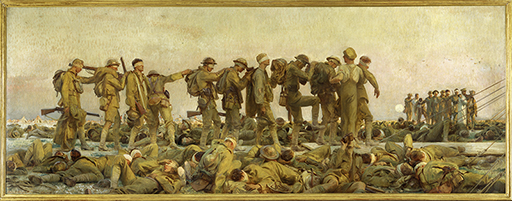3.2 War art – Example 2
The second example is of the famous painting ‘Gassed’ by John Singer Sargent.
Students’ skills development: ‘Gassed’
In the Imperial War Museum collection (Height: 2300 mm; Width: 6111 mm).
Analysis
Answer
John Singer Sargent was an American artist and well-known portrait painter by the time of the First World War. He was too old to serve in the conflict himself but was commissioned by the War Memorials Committee to document the war in the summer of 1918. He travelled to the Western Front and spent time with both British and American forces.
Answer
The painting was painted in late 1918 and early 1919 and was based on a scene that Sargent had witnessed when touring the Western Front in 1918. The painting was made after the armistice – a time when individuals and the British state were seeking to memorialise the conflict.
Answer
Sargent was commissioned specifically to produce a large, ‘epic’ painting that could be used for commemorative purposes. The Ministry of Information (the successor to the Department of Information) had created the War Memorials Committee in February 1918 in order to commission artworks for this purpose. It intended these paintings to be housed in a ‘Hall of Remembrance’, which was never built. The painting was eventually acquired by the Imperial War Museum, which was established in 1917 with the purpose of commemorating the war.
Answer
‘Gassed’ was first displayed at the Royal Academy in London in 1919. Over 6 metres in length, and more than 2 metres tall, this imposing painting had a powerful impact on those who viewed it. It was very well received and was awarded painting of the year by the Royal Academy of Arts.
Answer
This oil painting depicts the consequences of a poison gas attack: a line of temporarily blinded soldiers with bandaged eyes are being led by a medical orderly to a dressing station (indicated by the tent ropes to the right of the picture). Other men injured by poison gas are depicted lying down in the foreground, whilst another line of soldiers in the background can be seen walking towards the dressing station. In the far background, we can see men playing football in front of the setting sun.
Like Owen’s ‘Dulce et Decorum Est’, the painting provides an insight into the impact of poison gas on the human body. The painting was based on a scene that Sargent himself had witnessed, and photographic evidence of similar scenes exists. The source also reflects how people sought to memorialise the war during its immediate aftermath. Though the painting does not directly critique the war in the same way as Nevinson’s ‘Paths of Glory’, it does emphasise suffering rather than heroism. Even official forms of war art, therefore, had to recognise the human cost of the war by this stage. It was also easier for artists do so after the war, when military recruitment and civilian morale were no longer major concerns.
Answer
As with all artistic works, the painting needs to be understood as an imaginative interpretation rather than a direct reproduction of the events witnessed. Sargent’s exact views on the war are also hard gauge from this painting alone; in this sense, it has limitations as a source. It’s important that students don’t immediately characterise this as a an ‘anti-war’ piece, despite its depiction of suffering.
The painting should not be read as a condemnation of the British war effort. Nevertheless, though it was an officially commissioned artwork, it’s clear that Sargent did not want to depict the war as glorious or heroic. These ambiguities should be stressed.
Did you know?
You can find other examples of First World War art on the Imperial War Museum’s website [Tip: hold Ctrl and click a link to open it in a new tab. (Hide tip)] . First click on ‘Objects & History’ and then on ‘Find an Object’. This will allow you to search for items in the museum’s collections. By searching for an artist’s surname (e.g., ‘Nevinson’) and filtering the object category to ‘art’, users can quickly view many of the artist’s paintings held at the museum.
The museum also produces learning resources for school students of various ages. Click on ‘Learn’ and then ‘Learning Resources’ to view these. You can then filter the results to find material relating to the First World War. This article, for example, discusses interesting examples of First World War art that could be used as primary sources in the classroom. Useful historical context is also available on the British Library’s website.
The next section will focus on war memorials as a source for historians.

